[English] 日本語
 Yorodumi
Yorodumi- PDB-1glu: CRYSTALLOGRAPHIC ANALYSIS OF THE INTERACTION OF THE GLUCOCORTICOI... -
+ Open data
Open data
- Basic information
Basic information
| Entry | Database: PDB / ID: 1glu | ||||||
|---|---|---|---|---|---|---|---|
| Title | CRYSTALLOGRAPHIC ANALYSIS OF THE INTERACTION OF THE GLUCOCORTICOID RECEPTOR WITH DNA | ||||||
 Components Components |
| ||||||
 Keywords Keywords | TRANSCRIPTION/DNA / PROTEIN-DNA COMPLEX / DOUBLE HELIX / TRANSCRIPTION-DNA COMPLEX | ||||||
| Function / homology |  Function and homology information Function and homology informationnuclear receptor-mediated corticosteroid signaling pathway / negative regulation of behavioral fear response / HSP90 chaperone cycle for steroid hormone receptors (SHR) in the presence of ligand / muscle atrophy / negative regulation of synaptic plasticity / positive regulation of nuclear receptor-mediated glucocorticoid signaling pathway / nuclear receptor-mediated glucocorticoid signaling pathway / negative regulation of long-term synaptic depression / response to inactivity / regulation of glucocorticoid biosynthetic process ...nuclear receptor-mediated corticosteroid signaling pathway / negative regulation of behavioral fear response / HSP90 chaperone cycle for steroid hormone receptors (SHR) in the presence of ligand / muscle atrophy / negative regulation of synaptic plasticity / positive regulation of nuclear receptor-mediated glucocorticoid signaling pathway / nuclear receptor-mediated glucocorticoid signaling pathway / negative regulation of long-term synaptic depression / response to inactivity / regulation of glucocorticoid biosynthetic process / nuclear glucocorticoid receptor activity / SUMOylation of intracellular receptors / positive regulation of cell growth involved in cardiac muscle cell development / Nuclear Receptor transcription pathway / response to mercury ion / steroid hormone binding / glucocorticoid metabolic process / response to cortisol / neuroinflammatory response / Leydig cell differentiation / mammary gland duct morphogenesis / microglia differentiation / cellular response to magnesium ion / maternal behavior / response to arsenic-containing substance / astrocyte differentiation / negative regulation of vascular permeability / positive regulation of glutamate secretion / adrenal gland development / regulation of gluconeogenesis / cellular response to glucocorticoid stimulus / response to corticosterone / cellular response to steroid hormone stimulus / response to dexamethasone / positive regulation of dendritic spine development / motor behavior / hormone binding / androgen metabolic process / regulation of glucose metabolic process / associative learning / response to electrical stimulus / estrogen response element binding / cellular response to dexamethasone stimulus / nuclear receptor-mediated steroid hormone signaling pathway / cellular response to transforming growth factor beta stimulus / postsynaptic density, intracellular component / core promoter sequence-specific DNA binding / steroid binding / heat shock protein binding / Hsp70 protein binding / transcription initiation-coupled chromatin remodeling / lung development / TBP-class protein binding / positive regulation of cytokine production / response to activity / RNA polymerase II transcription regulatory region sequence-specific DNA binding / synaptic transmission, glutamatergic / promoter-specific chromatin binding / Hsp90 protein binding / female pregnancy / response to insulin / circadian rhythm / response to calcium ion / receptor tyrosine kinase binding / response to wounding / positive regulation of miRNA transcription / DNA-binding transcription repressor activity, RNA polymerase II-specific / spindle / nuclear receptor activity / sequence-specific double-stranded DNA binding / positive regulation of neuron apoptotic process / regulation of cell population proliferation / double-stranded DNA binding / protein-containing complex assembly / DNA-binding transcription activator activity, RNA polymerase II-specific / gene expression / dendritic spine / sequence-specific DNA binding / transcription coactivator activity / nuclear speck / RNA polymerase II cis-regulatory region sequence-specific DNA binding / chromatin remodeling / DNA-binding transcription factor activity / negative regulation of DNA-templated transcription / centrosome / chromatin binding / regulation of DNA-templated transcription / regulation of transcription by RNA polymerase II / protein kinase binding / negative regulation of apoptotic process / chromatin / protein-containing complex binding / glutamatergic synapse / negative regulation of transcription by RNA polymerase II / positive regulation of transcription by RNA polymerase II / protein-containing complex / mitochondrion / DNA binding / zinc ion binding / identical protein binding Similarity search - Function | ||||||
| Biological species |  | ||||||
| Method |  X-RAY DIFFRACTION / Resolution: 2.9 Å X-RAY DIFFRACTION / Resolution: 2.9 Å | ||||||
 Authors Authors | Luisi, B.F. / Xu, W.X. / Otwinowski, Z. / Freedman, L.P. / Yamamoto, K.R. / Sigler, P.B. | ||||||
 Citation Citation |  Journal: Nature / Year: 1991 Journal: Nature / Year: 1991Title: Crystallographic analysis of the interaction of the glucocorticoid receptor with DNA. Authors: Luisi, B.F. / Xu, W.X. / Otwinowski, Z. / Freedman, L.P. / Yamamoto, K.R. / Sigler, P.B. | ||||||
| History |
|
- Structure visualization
Structure visualization
| Structure viewer | Molecule:  Molmil Molmil Jmol/JSmol Jmol/JSmol |
|---|
- Downloads & links
Downloads & links
- Download
Download
| PDBx/mmCIF format |  1glu.cif.gz 1glu.cif.gz | 72.8 KB | Display |  PDBx/mmCIF format PDBx/mmCIF format |
|---|---|---|---|---|
| PDB format |  pdb1glu.ent.gz pdb1glu.ent.gz | 47.5 KB | Display |  PDB format PDB format |
| PDBx/mmJSON format |  1glu.json.gz 1glu.json.gz | Tree view |  PDBx/mmJSON format PDBx/mmJSON format | |
| Others |  Other downloads Other downloads |
-Validation report
| Summary document |  1glu_validation.pdf.gz 1glu_validation.pdf.gz | 384.7 KB | Display |  wwPDB validaton report wwPDB validaton report |
|---|---|---|---|---|
| Full document |  1glu_full_validation.pdf.gz 1glu_full_validation.pdf.gz | 447.7 KB | Display | |
| Data in XML |  1glu_validation.xml.gz 1glu_validation.xml.gz | 13 KB | Display | |
| Data in CIF |  1glu_validation.cif.gz 1glu_validation.cif.gz | 18.3 KB | Display | |
| Arichive directory |  https://data.pdbj.org/pub/pdb/validation_reports/gl/1glu https://data.pdbj.org/pub/pdb/validation_reports/gl/1glu ftp://data.pdbj.org/pub/pdb/validation_reports/gl/1glu ftp://data.pdbj.org/pub/pdb/validation_reports/gl/1glu | HTTPS FTP |
-Related structure data
- Links
Links
- Assembly
Assembly
| Deposited unit | 
| ||||||||
|---|---|---|---|---|---|---|---|---|---|
| 1 |
| ||||||||
| Unit cell |
| ||||||||
| Atom site foot note | 1: LYS A 435 - PRO A 436 OMEGA ANGLE = 121.694 PEPTIDE BOND DEVIATES SIGNIFICANTLY FROM TRANS CONFORMATIO |
- Components
Components
| #1: DNA chain | Mass: 5804.773 Da / Num. of mol.: 2 / Source method: obtained synthetically #2: Protein | Mass: 9133.866 Da / Num. of mol.: 2 Source method: isolated from a genetically manipulated source Source: (gene. exp.)  Gene (production host): GENE FRAGMENT (AMINO ACIDS 440 TO 525) Production host:  #3: Chemical | ChemComp-ZN / #4: Water | ChemComp-HOH / | Sequence details | THE FIRST SIX AMINO ACID RESIDUES ARE CLONAL LINKERS, THEY ARE DIFFERENT FROM THE NATURAL SEQUENCE. | |
|---|
-Experimental details
-Experiment
| Experiment | Method:  X-RAY DIFFRACTION X-RAY DIFFRACTION |
|---|
- Sample preparation
Sample preparation
| Crystal | Density Matthews: 3.71 Å3/Da / Density % sol: 66.89 % | |||||||||||||||||||||||||||||||||||||||||||||||||||||||||||||||||||||||||||||
|---|---|---|---|---|---|---|---|---|---|---|---|---|---|---|---|---|---|---|---|---|---|---|---|---|---|---|---|---|---|---|---|---|---|---|---|---|---|---|---|---|---|---|---|---|---|---|---|---|---|---|---|---|---|---|---|---|---|---|---|---|---|---|---|---|---|---|---|---|---|---|---|---|---|---|---|---|---|---|
| Crystal grow | Temperature: 281 K / Method: vapor diffusion / pH: 6 / Details: pH 6.00, VAPOR DIFFUSION, temperature 281.00K | |||||||||||||||||||||||||||||||||||||||||||||||||||||||||||||||||||||||||||||
| Components of the solutions |
| |||||||||||||||||||||||||||||||||||||||||||||||||||||||||||||||||||||||||||||
| Crystal grow | *PLUS Temperature: 8 ℃ / pH: 6 / Method: vapor diffusion, hanging drop | |||||||||||||||||||||||||||||||||||||||||||||||||||||||||||||||||||||||||||||
| Components of the solutions | *PLUS
|
-Data collection
| Diffraction | Mean temperature: 263 K |
|---|---|
| Diffraction source | Source:  ROTATING ANODE ROTATING ANODE |
| Detector | Type: SDMS / Detector: AREA DETECTOR |
| Radiation | Scattering type: x-ray |
| Radiation wavelength | Relative weight: 1 |
- Processing
Processing
| Software |
| ||||||||||||||||||||||||||||||||||||||||||||||||||||||||||||
|---|---|---|---|---|---|---|---|---|---|---|---|---|---|---|---|---|---|---|---|---|---|---|---|---|---|---|---|---|---|---|---|---|---|---|---|---|---|---|---|---|---|---|---|---|---|---|---|---|---|---|---|---|---|---|---|---|---|---|---|---|---|
| Refinement | Rfactor Rwork: 0.196 / Rfactor obs: 0.196 / Highest resolution: 2.9 Å | ||||||||||||||||||||||||||||||||||||||||||||||||||||||||||||
| Refinement step | Cycle: LAST / Highest resolution: 2.9 Å
| ||||||||||||||||||||||||||||||||||||||||||||||||||||||||||||
| Refine LS restraints |
| ||||||||||||||||||||||||||||||||||||||||||||||||||||||||||||
| Refinement | *PLUS Highest resolution: 2.9 Å / Lowest resolution: 6.5 Å / Num. reflection obs: 7669 / Rfactor obs: 0.196 | ||||||||||||||||||||||||||||||||||||||||||||||||||||||||||||
| Solvent computation | *PLUS | ||||||||||||||||||||||||||||||||||||||||||||||||||||||||||||
| Displacement parameters | *PLUS | ||||||||||||||||||||||||||||||||||||||||||||||||||||||||||||
| Refine LS restraints | *PLUS Type: x_angle_d / Dev ideal: 2.4 |
 Movie
Movie Controller
Controller




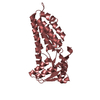
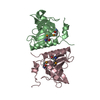

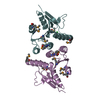
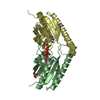
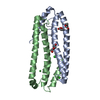
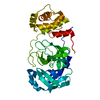
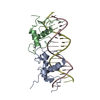
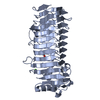

 PDBj
PDBj









































